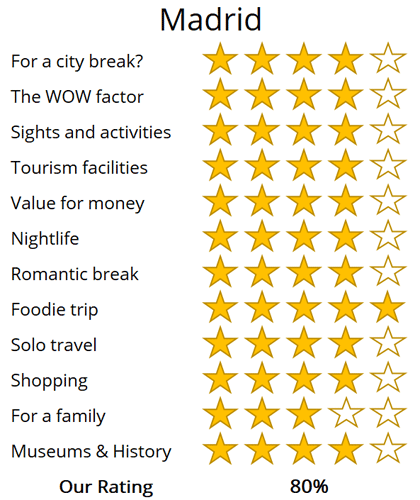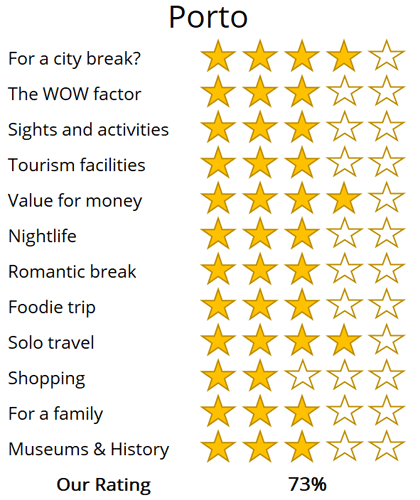WhereToGoForMyHoliday.com
The best destination comparison site!
WhereToGoForMyHoliday.com
The best destination comparison site!
Madrid or Porto, which is better for your holiday in 2024?
Porto and Madrid both offer unique and enticing experiences, but which one should you choose for your city break or holiday?
We recognise the difficulty in making this decision. While there is abundant information available on both destinations, clear guidance on which city better aligns with your travel preferences is often hard to find.
This article aims to provide an impartial comparison,and hopefully help you to choose the best city to visit.
The article is structured into several sections, each of which can be directly accessed through the following links:
• Introduction to the cities
• Scores and ratings
• Which one should I, friends, or family visit?
• When to visit and weather
• Who is the city suited for?
• The perfect 48hours (with map)
• Tourism details (where to stay? airport details?)
Introduction to Madrid and Porto
Porto is the surprise of western Europe. This hardworking and unassuming city seems to have stumbled into tourism without even realising its own potential. The variety of historic sights, personable atmosphere, along with a glass of sweet Port wine, creates a wonderful tourist destination.
Porto may be comparatively small and virtually unknown, but it can rival any of the more established tourist destinations. The unique appeal of Porto is that it is not swamped by tourists in the summer season, and is ideal for a summertime city break.

Porto lines the banks of the Douro River
Being the original artisan city of western Europe, Madrid’s galleries and museums are unrivalled, and are a staple for any cultural holiday.
However beneath this formal exterior is a young and passionate city, with thrilling nightlife, delicious food and genuinely welcoming locals.
The visitors who rave most about Madrid are the long-stay residents – and there is something captivating about the city. The Museo del Prado, the Reina Sofía and the Bernabéu Stadium, for a different type of culture. Just avoid Madrid in August, when the entire city shuts down for the summer holidays.

The Plaza Mayor and the historic centre of Madrid
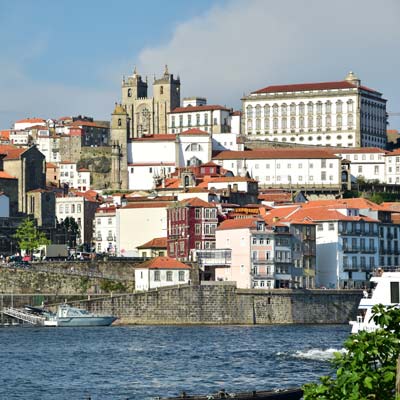
The Ribeira is the oldest district in Porto
High-level summary for Madrid or Porto
Summary
Where would I journey for a personal escape?
Madrid
Where would I send my parents for a memorable visit?
Porto
Where's the ideal destination for my adventurous 19-year-old cousin?
Madrid
Where should my food-obsessed friend indulge their culinary passions?
Madrid
Note: The above comparisons are weather-independent and are based on travel during the most opportune times of the year. Details about the ideal travel seasons are elaborated upon later in this article.
In the sections that follow, you'll find a comprehensive comparison between these two fascinating cities. This includes recommendations on the duration of stay, the best times to visit, and tailored 48-hour itineraries for each city.
The final segment delves into practicalities for your travels, such as the best airport to fly into, the optimal districts for your accommodation, and insider tips, for when you come to explore the city.
We hope that you find all of this information useful, in planning your next exciting trip!
Destination details
How long to spend each city?
For Madrid, the length of stay greatly depends on how much you want to devote to visit the three famed art galleries (Prado Museum, Thyssen-Bornemisza and Reina Sofía), or immerse into Spanish culture. The city can be seen in two days of sightseeing, and a third day is often given to the galleries.
There are many outstanding day trips from Madrid and a trip can be easily extended to 5 or 6 days. A selection of the best day trips includes the medieval town of Segovia, charming Toledo, and the magnificent El Escorial. Madrid makes for a good base from which to explore the region, and is served by inexpensive public transport
Porto is a compact city, and if rushed, all of the major tourist areas can be seen in a single day. Typically, we would recommend two days, which would include a short cruise along the Douro River and time for port tasting.
If you wished to extend your trip further, there are some great days out to the historic towns of Guimarães, Braga and Aveiro. During the summer (Jun-Sep) there are beautiful beaches along the Costa Verde coastline, and you could visit the resort towns of Espinho, Vila do Conde or Matosinhos.
Related articles: 2 days in Porto – 1 week in Porto
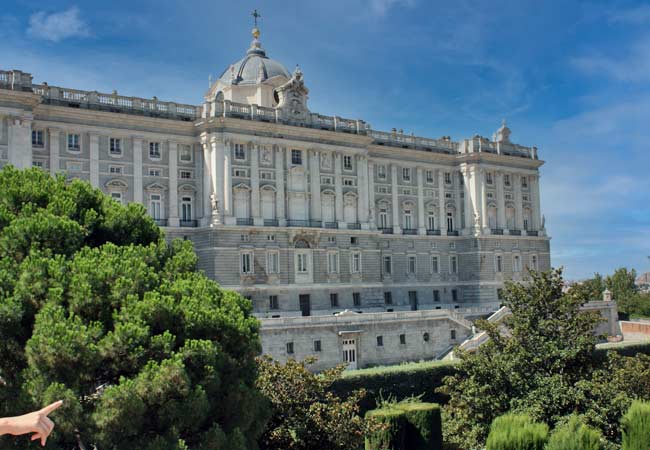
The magnificent Palacio Real in Madrid
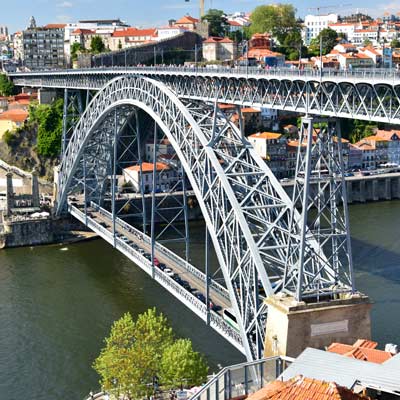
The Ponte Luís I bridge in Porto spans the Douro River
The major consideration for Madrid, is to avoid August. The entire city shuts down for the month, and everyone heads to the slightly cooler coastal towns.
The best time of year for Madrid is late spring (Jun/Jul) or early autumn. Madrid can be surprisingly chilly in the winter, but is comparatively drier and milder than the rest of northern Europe. As Madrid is in the centre of the Iberian Peninsula, it tends to get more extreme weather than the coastal cities.
Porto is one of the best European cities for a summer city break. While the rest of southern Europe swelters under the unbearable summer heat, Porto experiences pleasant weather and is not completely overrun by tourists.
Winters are mild and wet, and there is a high chance of rain from October through to May. The middle of June is the best time to visit the city when the Santos Populares festivals are being held.
Madrid is one of the finest cities in Europe. The city may not have the iconic monuments and attention-grabbing tourist attractions, but in reality, there is a lot to see during a city break.
Much of Madrid’s tourist literature focuses on the museums and galleries (which are world-class), but this should not deter you; this is a fun-loving city, which has the best nightlife in Europe. No matter your style of trip, there will be something to love about the Spanish capital.
Madrid excels as a long-stay destination, and if you can work here, the city offers the perfect work/life balance.
The characteristics of Porto traditionally appealed to the older visitor; it is very safe and there is a pleasant unhurried ambience, with a slightly conservative attitude. This mature opinion of Porto is often compounded by the most popular activities; Douro River cruises and Port tasting (which is great fun!).
This demographic of visitors to Porto is rapidly evolving, as younger travellers realise it is actually a progressive city, with a lot to see and do. Porto will appeal to those looking for somewhere slightly different, but who want a hassle-free trip with decent tourist facilities. Being one of the safest cities in Europe makes it ideal for solo/female travellers.
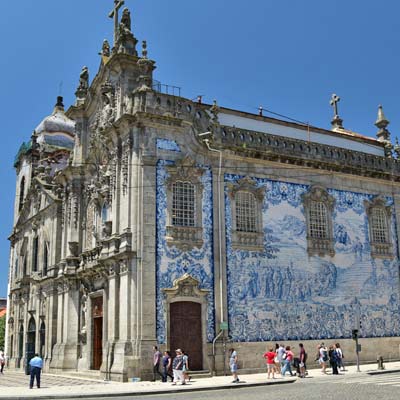
The beautiful Azulejo tile painting on the side of the Igreja do Carmo, Porto

The Museo Nacional del Prado, is one of the finest art galleries in the world
Porto
Considering the size of Porto there is a lot to see, and you can pack in a lot in a 48 hour visit.
Below is an interactive map of where we recommend to go in 48 hours in Porto; day 1 is highlighted in green and day 2 in yellow, with optional sights marked in grey.
A tour of Porto typically starts in the Se district, with the gothic cathedral and ancient city walls. Next is the Baixa district, where you can find the Avenida dos Aliados, and enjoy the view from the top of the Clérigos Tower.
For the latter part of the day and evening visit the ancient Ribeira district, which lines the banks of the Douro River. For the evening, join one of the boat cruises along the river or to party head to the Vitória district.
On the morning of the second day, ride the traditional tram to the Foz district, which is positioned at the mouth of the Douro River and extends along a rocky coastline to the beach of Matosinhos.
In the afternoon, and the highlight of Porto, are the tours of the Port cellars and Port tasting. Lining the southern banks of the Douro River are eight of the major Port producers, each with their vast cellars and tasting tours. You’ll happily leave Porto a Port connoisseur and a little tipsy…
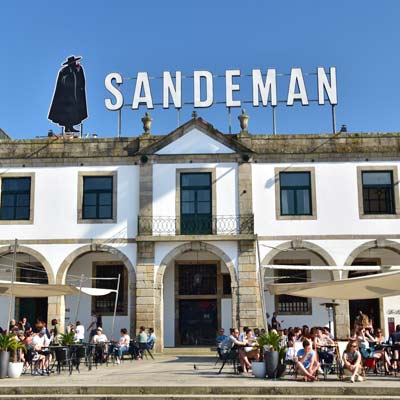
Port tasting at the Sandeman cellars– an enjoyable activity and a great way to meet fellow travellers
Madrid
48 hours in Madrid is not just the sights but also the atmosphere of the city. Below is an interactive tour map - day 1 is highlighted in green and day 2 in yellow, with optional sights marked grey.
Day 1 - 1) Puerta del Sol 2) Plaza Mayor 3) Plaza de la Villa 4) Mercado de San Miguel 5) Plaza de Oriente 7) Palacio Real 8) Almudena cathedral 9) Basílica de san Francisco 10) Calle de la Cava Alta
Day 2 - 11) Prado museum 12) Thyssen-Bornemisza Museum13) Museo Nacional Reina Sofía 14) Parque de El Retiro 15) Puerta de Alcalá 16) Palacio de Cibeles 17) Gran Vía 18) Malasaña district 19) Plaza de España 20) Templo de Debod
The 48 hours in Madrid begins in the Puerta del Sol, then wanders through charming streets of the El Madrid de los Austrias, which is the oldest section of the city. This leads to the Palacio Real, surrounded by its formal gardens and the Catedral de la Almudena to the south.
For the last part of the day explore the La Latina district and have a delicious tapas meal at one of the restaurants along the Cava Alta or Cava Baja. La Latina boasts numerous bars and is always a great place to start a night in Madrid.
The morning of the second focuses on the three art-museums, the Prado Museum, Thyssen-Bornemisza and Reina Sofía. Close to the museums is the pretty the El Retiro Park.
For the afternoon head down the Gran Vía, the main shopping street of Madrid, and visit the Malasaña district, with its artisan vibe, independent shops and trendy nightlife. For sunset watch it at the Templo de Debod, and then head back to Malasaña for a memorable meal and evening.

The atmospheric Templo de Debod, is Egyptian temple which was moved to Madrid in 1968, due to the construction of the Aswan dam (which would have flooded the temple)

The Gran Vía is the bustling main avenue of Madrid
If you choose a good season to visit, then Madrid is ideal for a city break. There is just one airport severing Madrid and is only 13km from the historic centre. For onward travel take the metro (€1.50 single – 30 minutes). For flights, there is always high demand for Friday/Sunday flights to/from Madrid, so if planning a city break always book at least 6-8 weeks in advance.
On initial appearance Madrid seems to have ample supply of hotel and rental rooms, but this is slightly misleading, as the city is so sprawling.
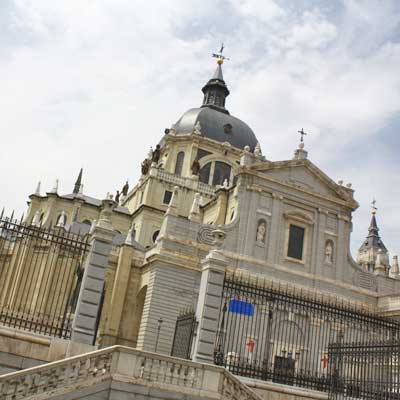
The Catedral de la Almudena
For your first visit, you would want to be based in the Centro or Retiro districts, and this will limit accommodation options. If you do wish a more remote, budget option always ensure it is close to a metro station. While exploring Madrid, you will do a surprising amount of walking.
Porto is a recommended destination for an alternative city break. Porto has a single airport which is 12km north of the historic centre and is connected by the metro. Porto has fewer flight routes and departures than other major cities, which means demand for weekend flights can be high. Equally, during the low season, there are bargain flights to be found.
Accommodation tends to be good value with ample supply, and most tourists are based in the Vitória, Sé or Baixa districts (all on the north side of the river). Porto can be easily explored on foot and rarely any public transport or taxis are needed for the entire trip. Just beware, there are steep hills!
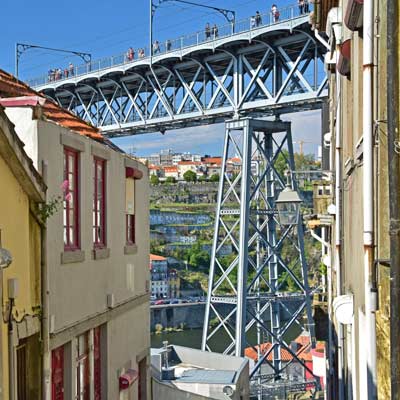
The pretty historic centre of Porto
The wow you’re going to…… factor
Porto has somehow managed to slip under the radar of most travellers and tourists, and this is a good thing. Few people even consider Porto, and consequently is hardly a bucket list location.
Madrid has been cool forever, and somehow this
Nightlife?
Madrid nightlife is legendary, it may start late but it will continue for as long as you are still standing. Madrid nightlife always has the perfect balance of Madrileños and foreigners, and the locals are generally social and fun. There are the artisan and fashionable bars of the Malasaña district or the mega clubs of Kapital or Barco. Popular nightlife districts include Lavapiés and La Latina. For something slightly different there a flamenco clubs and performances. Madrid’s nightlife is diverse, social and as wild as you want it, and certainly will not disappoint.
For Porto, the nightlife reflects that of the size of the city; Thursday, Friday and Saturday are lively and late-night, but early in the week is more tame. Porto’s nightlife is much more Portuguese focus and many venues are designed to accommodate the large student population. Porto is not really a destination to choose for extreme nightlife, but it is more about late dinners, socialising over a glass of Port.
-
Museums and galleries?
Madrid excels with museums and galleries, boasting three of Europe’s finest museum, within walking distance of each other. The Museo del Prado is the national art gallery of Spain and the Reina Sofía focuses on 20th-century art (notably Pablo Picasso and Salvador Dalí). The Thyssen-Bornemisza has over 1,600 paintings and is one of Europe’s largest private collections. It is easy to spend a day in each of these galleries; for art Madrid cannot be beaten.

Top 5 Porto, No.1:
The Port cellar tours and Port tasting
Porto may be the second city of Portugal but still boasts a couple of interesting museums. The Museu Serralves is a contemporary art museum, with the art extending to the tranquil gardens. Museu Nacional de Soares dos Reis exhibits Portuguese art of the 19th and 20th centuries and is housed in an elegant palace. The Museu da Misericórdia do Porto, has a wide selection of religious art.
-
Foodie trip, regional cuisines and eating out
Madrid is a city were mealtimes are the focus of the day, and a two-hour lunch is the norm. Madrid is famed for is tapas, but traditional food is much more heart such as Cocido Madrileño (Spanish stew), and a regional favourite is roasted sucking pig. There is decent seafood in Madrid and is surprisingly one of the world’s largest consumers of fish; this can be appreciated in the daily Mercado de Pescados (the fish market). Eating out in Madrid is always a pleasurable experience. There are so many outstanding family run restaurants in Madrid, most are never mentioned in any guide, and are just waiting for you to discover them.
-
Solo travel
Madrid is a social and vibrant city, which generally safe and suitable for solo travellers. There are cases of pick-pockets and opportunistic thefts, but no more than in any large city. Madrid is an important business and cultural centre, which attracts numerous solo travellers, many who may not even class themselves as solo travellers, as they are travelling for work or business. The city is not unfamiliar to solo travellers, and there are always many about.
Porto is one of the safest large cities in Europe. With its personable atmosphere and compact centre make it great for solo travellers. Porto may not attract the diversity and number of solo travellers as other destinations, but the safe setting makes it ideal as a trail for solo travel. Eating out along in a quiet restaurant, will often end up listening to tales and advice from the waiter or owner.

oh we were stuck in the airport!

Copenhagen was a bit expensive...

All we did was drink beer in Brussels...

Muncih was crazy

And we got so burnt!

Remeber that night in Rome

oh we were stuck in the airport

So much fun kayaking

Berlin and that group from Austria!

There was such a view from that church

And we got so burnt!

Munich was eventful, wasn't it!

Such a view from that cathedral in Florence

Lisbon was such so much fun

Last summer was so much fun .... x

Remeber that night in Rome

Lisbon was such so much fun

Such a view from that cathedral in Florence

Munich was eventful, wasn't it!

And we got so burnt!

Remeber that night in Rome

All we did was drink beer in Brussels...

Berlin and that group from Austria!

Can't wait to go back to Dubrovnik

Remember that boat ride in Prague

Copenhagen was a bit expensive...
